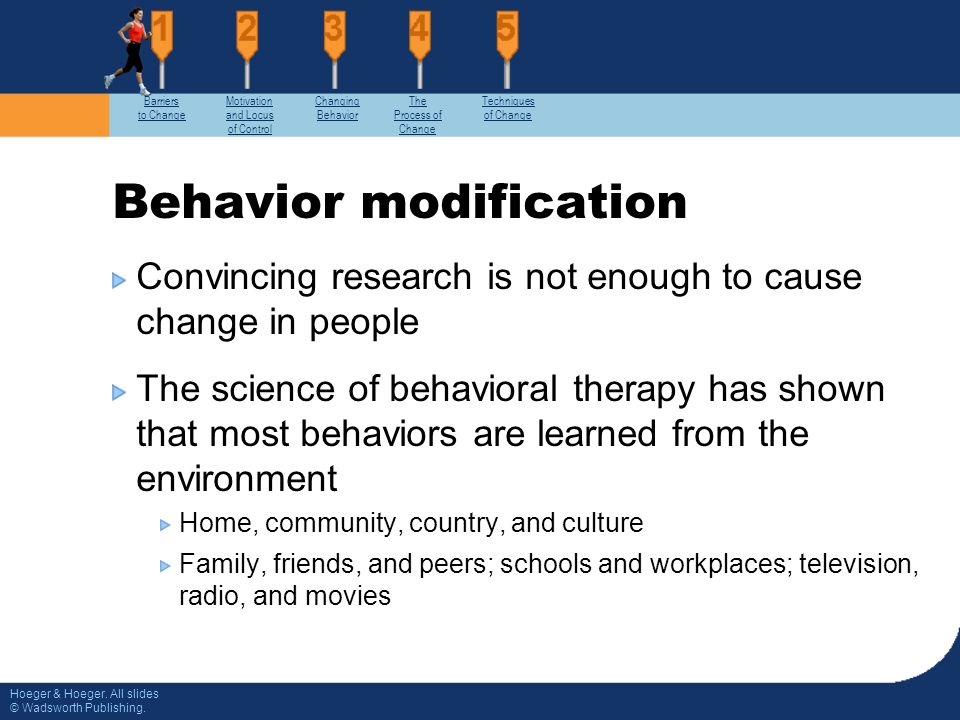
Behavior Modification - ppt video online download
4.5 (776) In stock

4.5 (776) In stock
Behavior modification Barriers to Change Motivation and Locus of Control Changing Behavior The Process of Change Techniques of Change Behavior modification Research has convincingly documented the benefits of physical activity and healthy lifestyles Most Americans accept this notion People are still unable to adhere to a healthy lifestyle program
Chapter Outline. Barriers to Change. Motivation and Locus of Control. Changing Behavior. The Process of Change. Techniques of Change. Chapter 2. Behavior Modification.
Barriers to Change. Motivation and Locus of Control. Changing Behavior. The Process of Change. Techniques of Change. Behavior modification. Research has convincingly documented the benefits of physical activity and healthy lifestyles. Most Americans accept this notion. People are still unable to adhere to a healthy lifestyle program.
Barriers to Change. Motivation and Locus of Control. Changing Behavior. The Process of Change. Techniques of Change. Behavior modification. Convincing research is not enough to cause change in people. The science of behavioral therapy has shown that most behaviors are learned from the environment. Home, community, country, and culture. Family, friends, and peers; schools and workplaces; television, radio, and movies.
Barriers to Change. Motivation and Locus of Control. Changing Behavior. The Process of Change. Techniques of Change. A toxic environment. We live in a toxic fitness and wellness environment. Physical inactivity is predominant. Learned behaviors; children watch adults. Drive short distances. Automatically use elevators, remote controls, etc. Order super-sized fast foods. Use recreational time to watch TV or surf the Internet. Smoke, drink, and abuse other drugs. Engage in risky behaviors, such as not wearing seat belts.
Barriers to Change. Motivation and Locus of Control. Changing Behavior. The Process of Change. Techniques of Change. A toxic environment. Food portions have increased at restaurants. Patrons consume large amounts of food. Food servings are excessive and unhealthy. Entire pitchers of soda pop or beer are served instead of 8-ounce cups. Restaurants are colorful, well-lit, and nicely decorated to enhance comfort and appetite.
Barriers to Change. Motivation and Locus of Control. Changing Behavior. The Process of Change. Techniques of Change. A toxic environment. Escalators are easier to find than stairways. Automatic doors provide unimpeded movement. Exercise trails are sparse. Sidewalks do not exist or are in disrepair. Safety concerns keep citizens indoors during leisure hours.
Barriers to Change. Motivation and Locus of Control. Changing Behavior. The Process of Change. Techniques of Change. Old habits die hard. Most people do not start life with a weight problem. The time comes, around middle age, when people want to change but find this difficult to accomplish.
Barriers to Change. Motivation and Locus of Control. Changing Behavior. The Process of Change. Techniques of Change. Barriers to change. Procrastination. Preconditioned cultural beliefs. Gratification. Risk complacency. Complexity. Indifference and helplessness. Rationalization. Illusions of invincibility.
Barriers to Change. Motivation and Locus of Control. Changing Behavior. The Process of Change. Techniques of Change. Barriers to change. The sooner a healthy lifestyle program is implemented, the greater will be the health benefits and quality of life ahead.
Figure % of Americans see a need to incorporate exercise into their lives. 70% of new and returning exercisers are at risk for early dropout.
Barriers to Change. Motivation and Locus of Control. Changing Behavior. The Process of Change. Techniques of Change. Critical thinking. What are the most frequent barriers to exercise that you encounter How about barriers that keep you from managing your daily caloric intake
Barriers to Change. Motivation and Locus of Control. Changing Behavior. The Process of Change. Techniques of Change. Key terms. Motivation: The desire and will to do something. Locus of control: The extent to which a person believes he or she can influence the external environment.
Barriers to Change. Motivation and Locus of Control. Changing Behavior. The Process of Change. Techniques of Change. Locus of control. People with internal locus of control are usually. Healthier. More successful in adhering to exercise. People with external locus of control usually. Feel powerless and vulnerable. Are at greater risk for illness. Few people have a completely external or internal locus of control.
Barriers to Change. Motivation and Locus of Control. Changing Behavior. The Process of Change. Techniques of Change. Impediments to change. Problems of competence. Work to master skills. Select activities where skill exists. Problems of confidence. Give the healthy behavior a fair try. Visualize success. Divide goals into smaller objectives. Problems of motivation. Gain knowledge about why change is necessary. Set goals.
Barriers to Change. Motivation and Locus of Control. Changing Behavior. The Process of Change. Techniques of Change. The process of change. Transtheoretical Model. Stages of change. Processes of change. Techniques of change.
Barriers to Change. Motivation and Locus of Control. Changing Behavior. The Process of Change. Techniques of Change. Action stage: Stage of change in which people are actively changing a negative behavior or adopting a new, healthy behavior. Maintenance stage: Stage of change in which people maintain behavioral change for up to 5 years. Termination/adoption stage: Stage of change in which people have eliminated an undesirable behavior or maintained a positive behavior for over 5 years. Relapse: To slip or fall back into unhealthy behavior(s) or fail to maintain healthy behaviors. Key terms. Precontemplation stage: Stage of change in which people are unwilling to change behavior. Contemplation stage: Stage of change in which people are considering changing behavior in the next 6 months. Preparation stage: Stage of change in which people are getting ready to make a change within the next month.
Transtheoretical model or stages of change model Figure 2.2
Barriers to Change. Motivation and Locus of Control. Changing Behavior. The Process of Change. Techniques of Change. Processes of change. Using the same plan for every individual who wishes to change a behavior will not work. Plans must be personalized. Timing is important in the process of willful change.
Barriers to Change. Motivation and Locus of Control. Changing Behavior. The Process of Change. Techniques of Change. Processes of change. Consciousness-raising. Social liberation. Self-analysis. Emotional arousal. Positive outlook.
Barriers to Change. Motivation and Locus of Control. Changing Behavior. The Process of Change. Techniques of Change. Processes of change. Commitment. Behavior analysis. Goal setting. Self-reevaluation. Countering.
Barriers to Change. Motivation and Locus of Control. Changing Behavior. The Process of Change. Techniques of Change. Processes of change. Monitoring. Environmental control. Helping relationships. Rewards.
Barriers to Change. Motivation and Locus of Control. Changing Behavior. The Process of Change. Techniques of Change. Techniques of change. Not to be confused with the processes of change. Within each process, apply any number of techniques of change to help you through that particular process. For example, following dinner, don’t snack. Instead, try go for a walk, go on a drive, play the piano, go to bed earlier. Use table 2.2 in the textbook for additional examples.
Barriers to Change. Motivation and Locus of Control. Changing Behavior. The Process of Change. Techniques of Change. Goal setting Goals are most effective if they are. Well planned. Personalized. Written. Realistic. Embraced with positive thoughts. Short-term and long-term. Measurable. Time-specific. Monitored. Evaluated.
Barriers to Change. Motivation and Locus of Control. Changing Behavior. The Process of Change. Techniques of Change. Critical thinking. Your friend John is a 20-year-old student who is not physically active. Exercise has never been a part of his life, and it has not been a priority in his family. He has decided to start a jogging and strength-training course in 2 weeks. Can you identify his current stage of change and list processes and techniques of change that will help him maintain a regular exercise behavior

What is Conflict Management?

Three Steps Behavior Modification Ppt Powerpoint Presentation Show
:max_bytes(150000):strip_icc()/Econometrics_4-3-v2-resized-bbc43da03e7d4a94827965767d7b96a8.jpg)
Econometrics: Definition, Models, and Methods

Exit Interview Template: What it is & 9 Templates to Follow
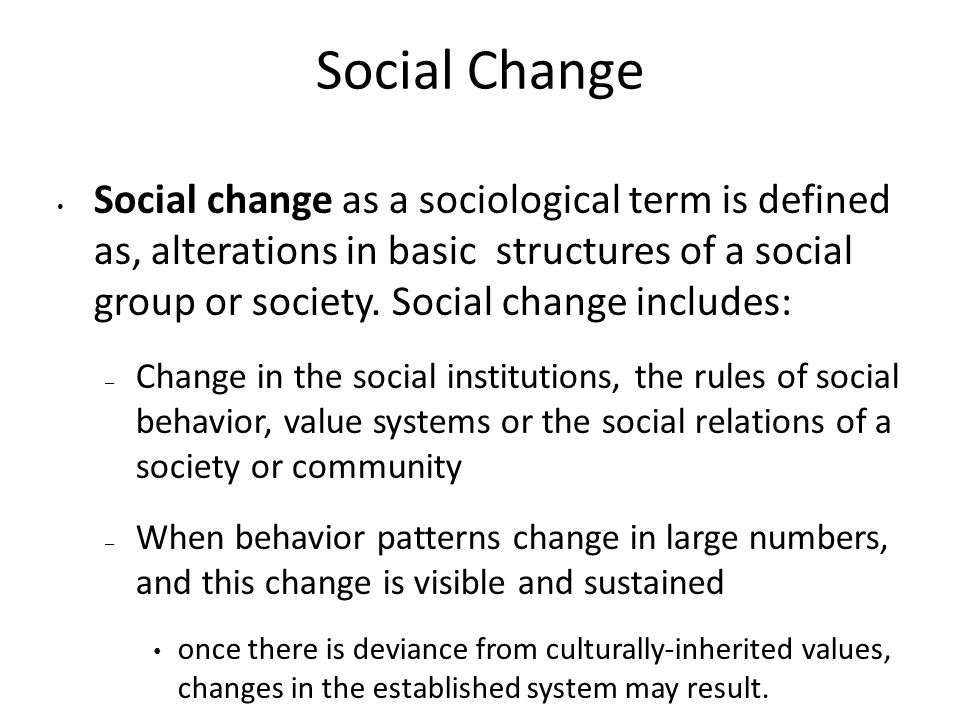
Social Change in Modern Society: Sociological theories of social
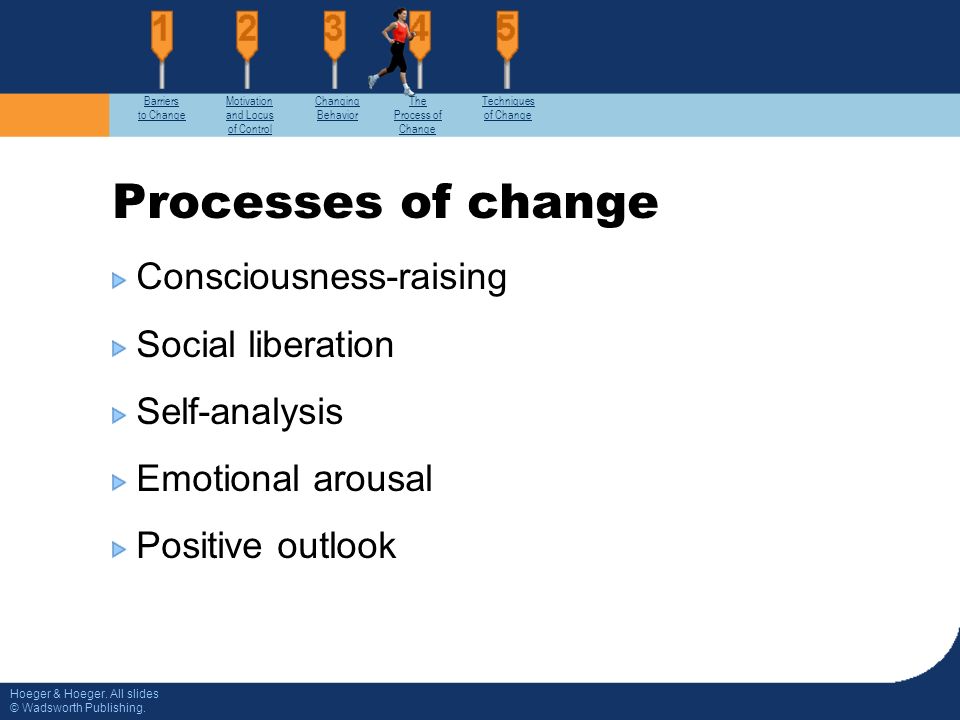
Behavior Modification - ppt video online download
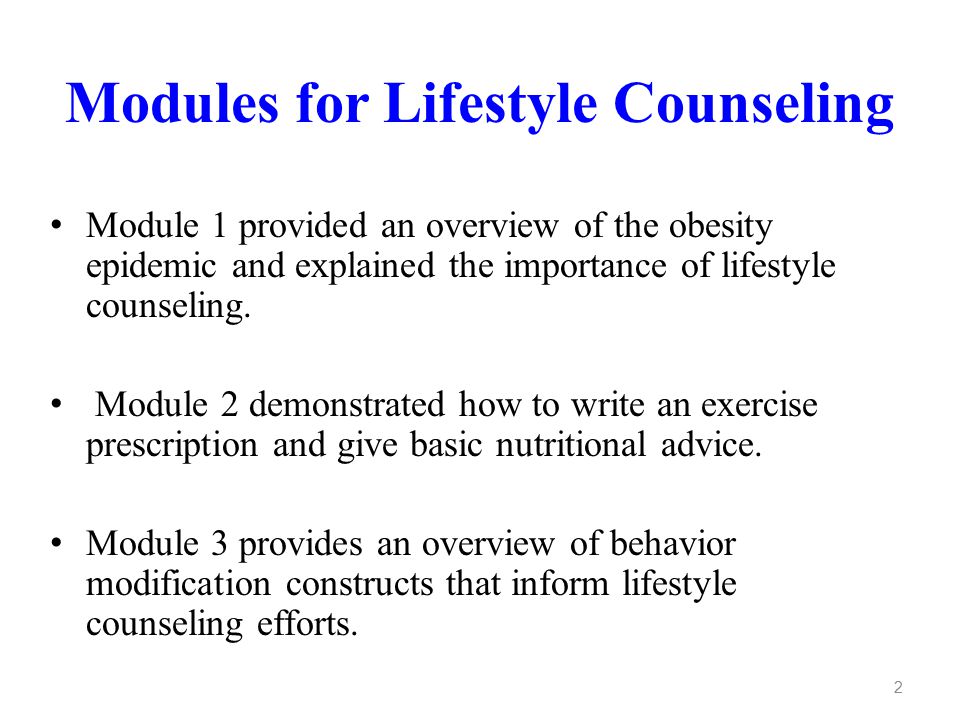
Module 3: Models of Behavior Modification - ppt video online download

Behavior Therapy Chapter 9. Behavior Therapy Basic Assumptions
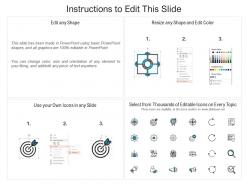
Behavior Modification Psychology Ppt Powerpoint Presentation Icon

PPT - Behavioral Modification PowerPoint Presentation, free
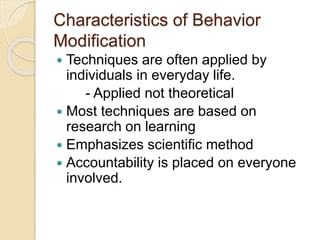
Behavior modification
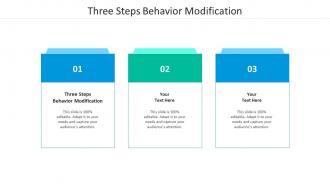
Three Steps Behavior Modification Ppt Powerpoint Presentation Show